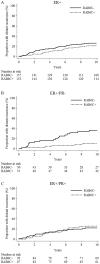RAB6C is an independent prognostic factor of estrogen receptor-positive/progesterone receptor-negative breast cancer
- PMID: 31897114
- PMCID: PMC6923975
- DOI: 10.3892/ol.2019.11109
RAB6C is an independent prognostic factor of estrogen receptor-positive/progesterone receptor-negative breast cancer
Abstract
The majority of breast cancer tumors are estrogen receptor-positive (ER+) and can be treated with endocrine therapy. However, certain patients may exhibit a good prognosis without systemic treatment. The aim of the present study was to identify novel prognostic factors for patients with ER+ breast cancer tumors using gene copy data, and to investigate if these factors have prognostic value in subgroups categorized by progesterone receptor status (PR). Public data, including the whole genome gene copy data of 199 systemically untreated patients with ER+ tumors, were utilized in the present study. To assess prognostic value, patients were divided into two groups using the median gene copy number as a cut-off for the SNPs that were the most variable. One SNP was identified, which indicated that the Ras-related protein Rab-6C (RAB6C) gene may exhibit prognostic significance. Therefore, RAB6C protein expression was subsequently investigated in a second independent cohort, consisting of 469 systematically untreated patients (of which 310 were ER+) who received long term follow-up. In the public data set, a distant recurrence risk reduction of 55% was determined for copy numbers above the median value of RAB6C compared with numbers below [multivariable adjusted hazard ratio (HR), 0.45; 95% CI 0.28-0.72; P=0.001)]. It was also more pronounced in the ER+/PR- subgroup (HR, 0.15; 95% CI, 0.05-0.46; P=0.001). In the second cohort, patients of the ER+/PR- subgroup who exhibited high RAB6C expression had a reduced distant recurrence risk (HR, 0.17; 95% CI, 0.05-0.60; P=0.006). However, this was not identified among ER+/PR+ tumors (HR, 1.31; 95% CI, 0.69-2.48; P=0.41). The results of the present study indicated that RAB6C serves as an independent prognostic factor of distant recurrence risk in systemically untreated patients with an ER+/PR- tumor.
Keywords: Ras-related protein Rab-6C; breast neoplasm; estrogen receptor; gene copy number; progesterone receptor; prognostic.
Copyright: © Fohlin et al.
Figures



Similar articles
-
Low RAB6C expression is a predictor of tamoxifen benefit in estrogen receptor-positive/progesterone receptor-negative breast cancer.Mol Clin Oncol. 2020 May;12(5):415-420. doi: 10.3892/mco.2020.2014. Epub 2020 Mar 9. Mol Clin Oncol. 2020. PMID: 32257197 Free PMC article.
-
Prognostic Value of the Progesterone Receptor by Subtype in Patients with Estrogen Receptor-Positive, HER-2 Negative Breast Cancer.Oncologist. 2019 Feb;24(2):165-171. doi: 10.1634/theoncologist.2018-0176. Epub 2018 Aug 31. Oncologist. 2019. PMID: 30171067 Free PMC article.
-
Genomic Landscape and Endocrine-Resistant Subgroup in Estrogen Receptor-Positive, Progesterone Receptor-Negative, and HER2-Negative Breast Cancer.Theranostics. 2018 Dec 8;8(22):6386-6399. doi: 10.7150/thno.29164. eCollection 2018. Theranostics. 2018. PMID: 30613307 Free PMC article.
-
Prognostic Impact of Progesterone Receptor Status in Chinese Estrogen Receptor Positive Invasive Breast Cancer Patients.J Breast Cancer. 2017 Jun;20(2):160-169. doi: 10.4048/jbc.2017.20.2.160. Epub 2017 Jun 26. J Breast Cancer. 2017. PMID: 28690652 Free PMC article.
-
Gene expression of estrogen receptor, progesterone receptor and microtubule-associated protein Tau in high-risk early breast cancer: a quest for molecular predictors of treatment benefit in the context of a Hellenic Cooperative Oncology Group trial.Breast Cancer Res Treat. 2009 Jul;116(1):131-43. doi: 10.1007/s10549-008-0144-9. Epub 2008 Jul 31. Breast Cancer Res Treat. 2009. PMID: 18668363 Clinical Trial.
Cited by
-
Advanced Magnetic Resonance Imaging Modalities for Breast Cancer Diagnosis: An Overview of Recent Findings and Perspectives.Diagnostics (Basel). 2022 Nov 9;12(11):2741. doi: 10.3390/diagnostics12112741. Diagnostics (Basel). 2022. PMID: 36359584 Free PMC article. Review.
-
Stratification of Estrogen Receptor-Negative Breast Cancer Patients by Integrating the Somatic Mutations and Transcriptomic Data.Front Genet. 2021 Feb 3;12:610087. doi: 10.3389/fgene.2021.610087. eCollection 2021. Front Genet. 2021. PMID: 33613637 Free PMC article.
-
Low RAB6C expression is a predictor of tamoxifen benefit in estrogen receptor-positive/progesterone receptor-negative breast cancer.Mol Clin Oncol. 2020 May;12(5):415-420. doi: 10.3892/mco.2020.2014. Epub 2020 Mar 9. Mol Clin Oncol. 2020. PMID: 32257197 Free PMC article.
References
-
- Gruvberger S, Ringnér M, Chen Y, Panavally S, Saal LH, Borg A, Fernö M, Peterson C, Meltzer PS. Estrogen receptor status in breast cancer is associated with remarkably distinct gene expression patterns. Cancer Res. 2001;61:5979–5984. - PubMed
-
- Early Breast Cancer Trialists' Collaborative Group (EBCTCG) Davies C, Godwin J, Gray R, Clarke M, Cutter D, Darby S, McGale P, Pan HC, Taylor C, et al. Relevance of breast cancer hormone receptors and other factors to the efficacy of adjuvant tamoxifen: Patient-level meta-analysis of randomised trials. Lancet. 2011;378:771–784. doi: 10.1016/S0140-6736(11)60993-8. - DOI - PMC - PubMed
LinkOut - more resources
Full Text Sources
Research Materials
